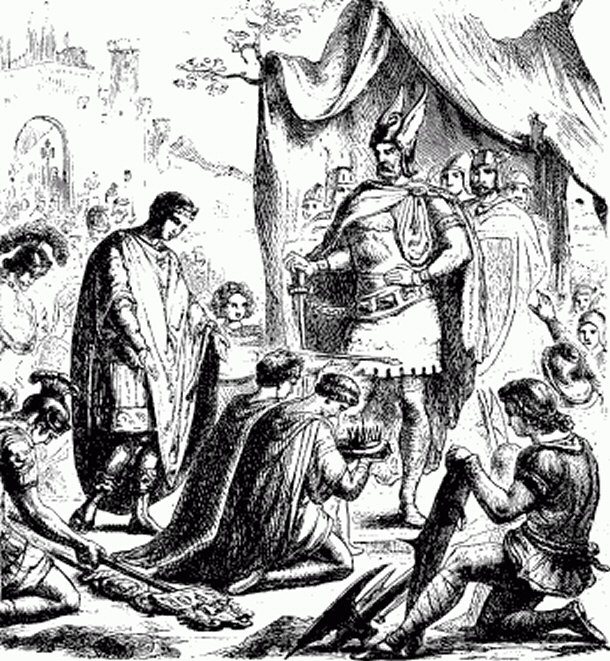 |
| Romulus Augustus resigning the crown before Odovacar |
The Ostrogoths and Lombards were Germanic barbarians who successively became rulers of post-Roman Italy. The Ostrogoths were the eastern branch of the Gothic peoples, the western being the Visigoths. They first settled in the area of the Ukraine. An early Ostrogothic king, Ermanric, was defeated and conquered by the Huns around 375 c.e.
Like other German peoples, the Ostrogoths regained their independence and entered the Roman Empire as Roman allies following the death of the Hunnish king Attila in 453. The Ostrogoths’ most important king was Theodoric, who became king in 474. After ravaging Thrace the young king was diverted westward by the Roman emperor Zeno in Constantinople.
Zeno hoped that Theodoric would overcome Odovacar, a former barbarian mercenary leader who had overthrown the last Roman emperor in the West, Romulus Augustulus, in 476. Theodoric quickly overcame Odovacar and treacherously murdered him.
  |
The Ostrogothic kingdom under Theodoric was the most "civilized" of the post-Roman barbarian kingdoms in the western Mediterranean, marked by the persistence of Roman civilization and the continued acknowledgment of the rule of the Roman emperor at Constantinople. The Roman Senate continued to meet, and many senators served Theodoric’s government. Like late Western Roman emperors, Theodoric’s capital was at Ravenna, not Rome.
Unlike other barbarian states, the Ostrogothic kingdom in Italy did not have different sets of laws for the Romans and the barbarians, although Goths tried Goths in military courts and Romans tried Romans in civilian courts. Like other barbarian states, however, Ostrogothic Italy faced the problem of religious differences.
The Ostrogoths were Arian Christians, denying the equality of Christ with God the Father, while their Roman subjects were Orthodox, accepting the doctrine of the Trinity. Toward the end of his reign Theodoric adopted a harsher policy toward the Senate and leading Romans for fear that they were conspiring with the Orthodox emperor.
His grandson Athalaric succeeded Theodoric, but the real power lay with his mother, Theodoric’s daughter Amalasuntha. Traditional Ostrogoths believed that Amalasuntha leaned too far to the Roman side, and she lacked Theodoric’s fame as a war leader.
In 534 she was imprisoned and strangled by her husband, Theodahad, who took the Ostrogothic crown for himself. The Ostrogothic kingdom, however, was in the path of the Roman emperor Justinian I, who aimed at destroying the Arian barbarian powers of the Mediterranean.
Proclaiming themselves avengers of Amalasuntha, a Roman army under the famed general Belisarius landed in Italy in 535. Theodahad, a poor leader, was deposed in favor of General Witiges, who was captured and taken to Constantinople in 540. (The Ostrogoths offered to make Belisarius their king, but he refused.)
The next Ostrogothic king to emerge, Totila, had some success and even retook Rome but was eventually defeated and killed in the Battle of Busta Gallorum in 552 by the Roman general Narses at the head of a mostly barbarian army. Soon afterward the Ostrogoths disappeared as a people.
The Roman destruction of the Ostrogoths and its accompanying devastation paved the way for the conquest of much of Italy by the much more barbaric Lombards. The Lombards had been established north of the Danube, where they came under increasing pressure from the Avars, a people originating in Central Asia.
Under the leadership of their king, Alboin, the Lombards invaded northern Italy and established a kingdom with its capital at Pavia. In subsequent decades they expanded their control over the peninsula.
Unlike the Ostrogoths, however, the Lombards never captured Rome or became masters of all Italy. Their kingdom was also never as centralized as that of their predecessors. The Lombards competed with dukes and the popes for Rome, and with the Eastern Roman or Byzantine emperors for the peninsula.
Outside the northern Lombard kingdom, semi-independent Lombard duchies were also established in the south, at Spoleto and Benevento. The Lombards, unlike the Ostrogoths, maintained the dual system of law for Romans and barbarians.
Over the course of time, however, they converted from their original pagan and Arian religions to the Catholicism of their subjects, which ended the religious issue with the papacy but left the territorial one.
The Byzantine emperors had relinquished their protection of the papacy after the fall of Ravenna to the Lombard king Aistulf in 751. However, the Lombard kingdom was ultimately destroyed by the Frankish kingdom.
The Frankish ruler Pepin the Short invaded Italy in 754, restoring to the papacy lands that the Lombards had taken but not subjugating the Lombard kingdom. He returned in 756, forcing Aistulf to acknowledge the Frank as his overlord.
The final destruction of the Lombard kingdom was the work of Pepin’s son and successor, Charlemagne, who in 774 made a prisoner of the last Lombard king, Desiderius, and had himself crowned with the iron crown of the Lombards.
Bereft of their privileges as a ruling elite, the Lombards of the north assimilated with their one-time Italian subjects, leaving the name of Lombardy to denote a region of northern Italy. The Normans conquered the last independent Lombard power, the duchy of Benevento, in the 11th century.